On May 2, 2014 China blatantly moved its Haiyang Shiyou - 981 drilling rig to Vietnam’s waters and installed the rig 80 miles into Vietnam’s waters. On May 27 China anchored its rig at a site of 15 degrees 33.38 minutes north latitude and 111 degrees 34.62 minutes east longitude, 25 nautical miles east-southeast of Tri Ton Island in Vietnam’s Hoang Sa (Paracel) Archipelago, 23 nautical miles east-northeast from the previous location. All the sites are in Vietnam’s continental shelf and exclusive economic zone. Furthermore, China maintains about 100 ships, including many large armed vessels and airplanes to protect its rig. China’s armed vessels aggressively fired high-powered water cannons at and intentionally rammed Vietnamese law enforcement ships, causing damage to many ships and injuring many people on board.
China’s acts gravely violate Vietnam’s sovereignty over Hoang Sa Archipelago as well as the sovereign right and jurisdiction over its exclusive economic zone and continental shelf prescribed by the 1982 United Nations Convention on the Law of the Sea (UNCLOS); violate international law on prohibition of threats or the use of force in international relations in general and solving disputes in particular; violate the Declaration on the Conduct of Parties in the East Sea to which China is a signatory; and is contrary to the agreement on the basic principles guiding the settlement of sea-related issues that Vietnam and China signed in 2011.
According to the 1982 UNCLOS, a coastal nation has rights to have an exclusive economic zone and continental shelf up to 200 nautical miles from the baseline. Within this area, the coastal nation has sole rights over all natural resources. Foreign nations have the freedom of navigation and over flight, subject to the regulation of the coastal states. If foreign states want to implement any economic activities in this area, they must receive permission from the coastal states.
China’s argument that its Haiyang Shiyou – 981 drilling rig is installed in the exclusive economic zone and continental shelf of the so-called “Tay Sa” (Hoang Sa) of China is totally illegal for the following reasons:
Firstly, Hoang Sa Archipelago does not belong to China and Vietnam has uncontroversial sovereignty over this archipelago. Vietnam has undeniable legal foundation and historical evidence proving Vietnam’s sovereignty over Hoang Sa (Paracel) and Truong Sa (Spratly) Archipelagoes. Since the 17th century, the Nguyen Dynasty established and practiced its sovereignty over the two archipelagoes. It also established the Hoang Sa Flotilla with the aim of managing, protecting and exploiting these archipelagoes without facing objections from any other country, including China. After such a long time, Vietnam has full legal foundation to strongly prove its sovereignty over Hoang Sa and Truong Sa since Vietnam’s feudal states. After the Nguyen Dynasty, during the French occupation of Vietnam, the French government, in the name of Vietnam, continued managing the two archipelagoes and opposed other countries’ claim over them. In 1956, China used force to occupy a group of islands to the east of Vietnam’s Hoang Sa. Later on, in 1974, China continued brazenly mobilizing forces to take control of the group of islands to the west of Vietnam’s Hoang Sa.
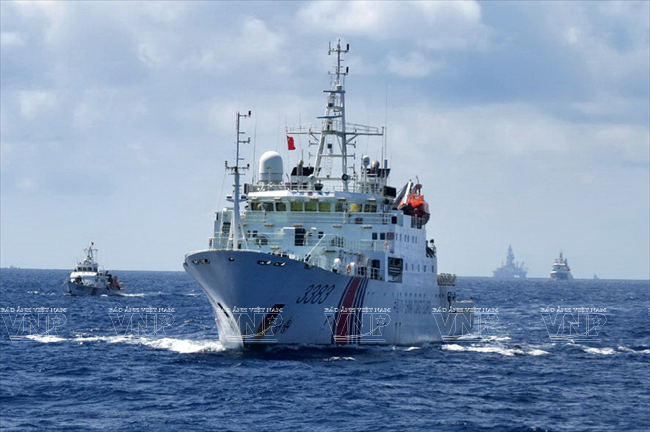 China mobilised a large number of military vessels to protect its Haiyang Shiyou – 981 drilling rig. Photo: Tuoi Tre Newspaper
China mobilised a large number of military vessels to protect its Haiyang Shiyou – 981 drilling rig. Photo: Tuoi Tre Newspaper
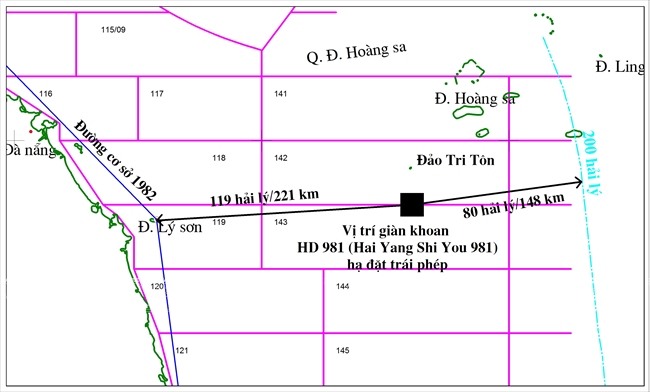
The map shows the location of China’s Haiyang Shiyou - 981 illegally installed
in Vietnam’s exclusive economic zone and continental shelf. Photo: VNA
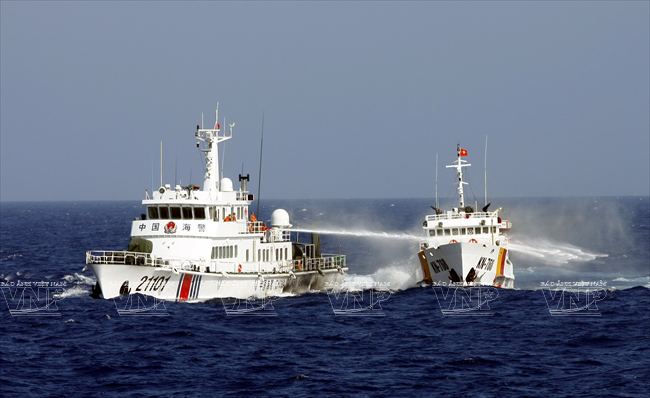
Chinese marine police vessel 21101 fires high-pressured water cannons
at Vietnamese fisheries surveillance vessel 768. Photo: Tuoi Tre Newspaper
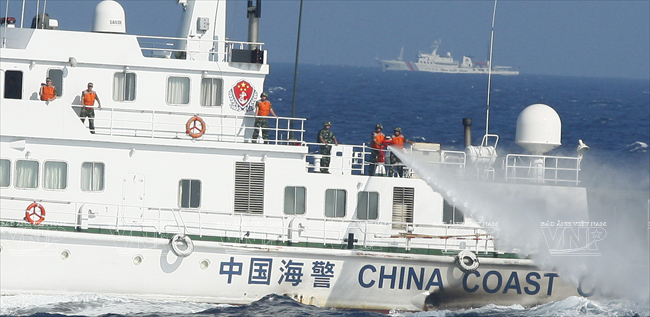
A Chinese coast guard vessel, which is well-equipped, fires high-powered water cannons
at a Vietnamese vessel. Photo: Tuoi Tre Newspaper
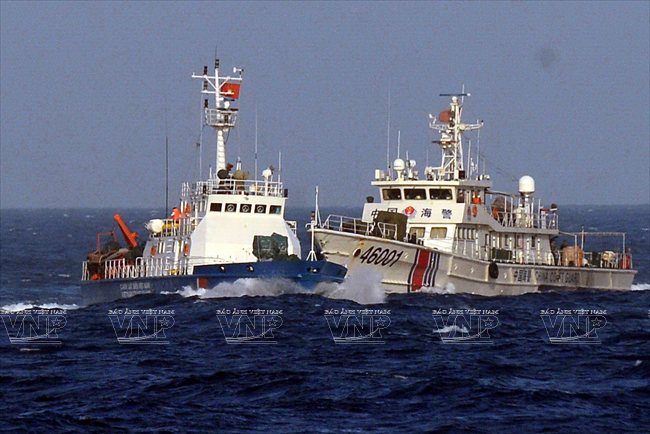
Chinese marine police vessel 46001 rams a Vietnamese coast guard vessel. Photo: Tuoi Tre Newspaper
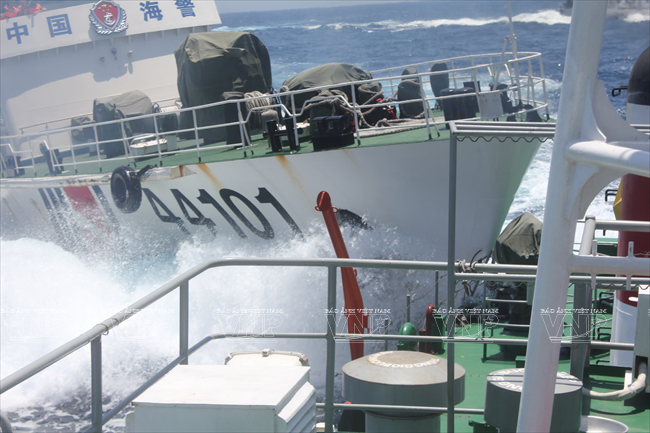
Chinese marine police vessel 44101 rams a Vietnamese coast guard vessel. Photo: Vietnam’s Coast Guard
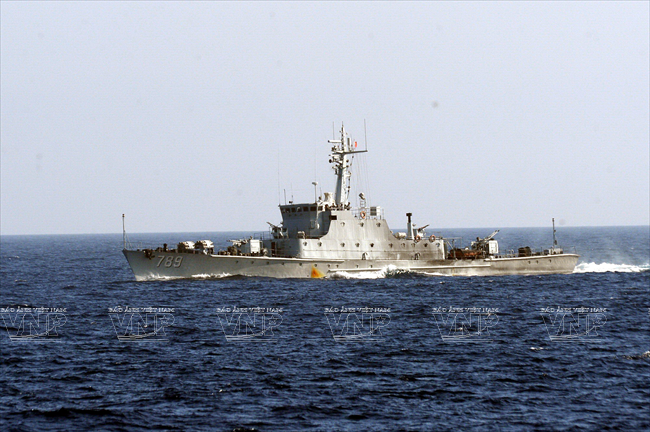
China’s guardian rocket ship, a military vessel, is present in Vietnam’s waters
where China illegally deployed its Haiyang Shiyou – 981 drill rig. Photo: Tuoi Tre Newspaper
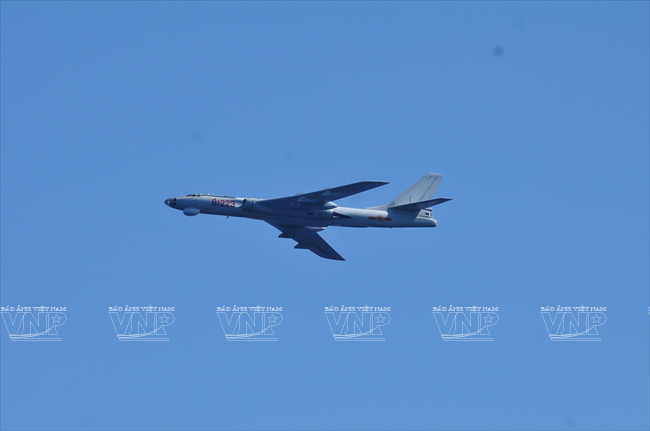 China’s aircrafts fly right above Vietnamese law enforcement vessels to intimidate and threaten them. Photo: Tuoi Tre Newspaper
China’s aircrafts fly right above Vietnamese law enforcement vessels to intimidate and threaten them. Photo: Tuoi Tre Newspaper
According to international law, using force to occupy the territory of other countries is not recognized so China’s claim about its sovereignty over Vietnam’s Hoang Sa is illegal. After 1974, Vietnam continued affirming its sovereignty over Hoang Sa and protesting China’s illegal activities as well as its claims about sovereignty over Hoang Sa. China’s claim that its Haiyang Shiyou - 981 drilling rig is stationed within the exclusive economic zone and continental shelf of China because Hoang Sa belongs to China has no legal foundation.
Secondly, it is impossible to say that China’s Haiyang Shiyou - 981 oil rig is stationed in the exclusive economic zone and the continental shelf of Hoang Sa. According to the 1982 UNCLOS, the islands in Hoang Sa, except for Phu Lam Island with an area of about 2.1km2, are sand dunes with an area of about 1.5.km2, have neither conditions to be the habitat for human beings nor to establish an economic life of their own. For all these reasons, it is impossible to claim the waters of these islands as that of the mainland.
Under the UNCLOS 1982, from the coastline of Vietnam, islands in Hoang Sa Archipelago can only have a territorial waters of 12 nautical miles and no exclusive economic zone or continental shelf. That affirmed that the location where China installed its Haiyang-Shiyou 981 oil rig, 17 and then 25 nautical miles from Tri Ton Island is within Vietnam’s exclusive economic zone and continental shelf which has no disputes.
China violates international law when moving its Haiyang-Shiyou 981 oil rig in Vietnam’s waters by using force and threats in using force. The UN charter bans the threat or use of armed force against the territorial integrity except in cases in self-defence and/or being allowed by the UN Security Council. All disputes must be settled by peaceful means. Yet, in recent days, China has mobilized a large number of vessels of different kinds, including military ships, maritime surveillance and transport ships, fishing vessels and dozens of low-flying aircrafts to escort its Haiyang Shiyou - 981 drilling rig to move into Vietnam’s waters. Furthermore, Chinese crew members also brandished cudgels and drew back a canvas gun cover to intimidate Vietnam’s coast guards from law enforcement activities. China’s actions clearly show the fact that China threatens to use armed force. More seriously, China’s armed vessels aggressively fired high-powered water cannons at and intentionally rammed Vietnamese law enforcement ships, causing damage to many ships, injuring many people on board and even sinking a Vietnamese fishing ship. These extremely dangerous actions have been threatening peace, stability, security and safety of navigation in the East Sea.
To protect its Haiyang Shiyou - 981 oil rig, China has also announced the three nautical mile safety zone around the illegally-placed oil rig. That is a perverse violation. According to the 1982 UNCLOS, a state is allowed to establish a safety zone up to 500 metres for work and equipment installed in the sea. In reality, China’s armed vessels prevent Vietnamese law enforcement ships from law enforcement activities from 30-40 nautical miles. This action has threatened freedom and maritime security and safety in the region.
In 2003 and 2004, China came up with the concept of “Peaceful Rise” and “Peaceful Development” to make the world secure about its development and pledged not to become the hegemony. In 2013, China introduced its diplomatic policy, accordingly Chinese leaders proposed joint construction of a peaceful “Maritime Silk Road” and signed a Treaty on Good Neighbourliness, Friendship and Cooperation with ASEAN. However, with its provocative actions in the East Sea since 2009, China has shown the world the fact that there is an increasing gap between China’s words and deeds and it creates an image of China which prefers using armed force in affirming sovereignty based on creating “new realities” in the East Sea. For the international community, China has become an aggressive nation which violates international law and threatens security, peace and stability in the region.
The larger the gap between words and deeds of China, the more decrease of confidence of nations in the region for China and China has become more isolated in the international and regional community. When the confidence about peaceful rise of China has no foundation, it is necessary and reasonable for countries in the region to look for competent measures, build new international cooperation relations, and even strengthen their competence of self-defence. It is completely contrary to the benefit of China both in the short term and long term because any powerful country must create a peaceful and cooperative environment in its neighbouring areas. Such an environment can not be built by gunboat diplomacy and the gunboat diplomacy cannot help build friendship.
Story: Dr. Nguyen Hung Son - Deputy Director General of the Institute for East Sea Studies
* Vietnam Pictorial gives the title to the article